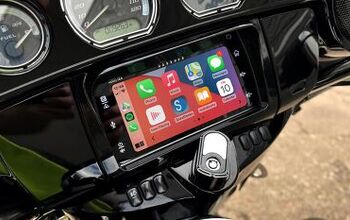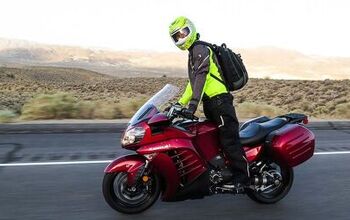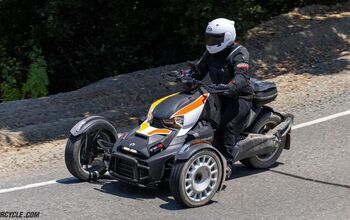Can You Ride a Motorcycle in the Rain?
Riding a motorcycle in the rain can be fun if you plan accordingly and develop good habits
Every motorcyclist will face rainy weather at some point in their riding careers. Understandably, a lot of riders are weary of wet conditions, but many of those concerns stem from a lack of preparation of our skills and gear. Motorcycling in the rain can be pretty fun if you're developing the right skills and wearing the right gear to keep you safe. So, when a curious reader asked, "Can you ride a motorcycle in the rain?" We knew it was an excellent time to discuss the dos and don'ts of rain riding.
Manage Mother Nature with the Right Gear
The right gear will change your experience out on the road, and it is also related to safety. Let's paint a picture of one extreme: When wet, cold, and miserable, a rider may struggle to maintain focus or even effectively operate the controls of their machine. These things happen, and sometimes you get caught in bad weather, but the right gear is the first and last line of defense against the elements.
As the saying goes, "Dress for success," which in our case means wearing waterproof riding apparel – jackets, pants, boots, and gloves – you get the idea. Adding insulating layers or an electric heated vest in colder conditions will dramatically improve your ride, keeping you toasty when the thermometer begins heading south.
Of course, we realize that having multiple sets of riding gear with waterproof liners or membranes isn't feasible for everyone. But, one affordable piece of equipment often found in MO editorial staff's travel bags are rain suits, which nearly every reputable motorcycle apparel maker offers. These waterproof layers come in one- or two-piece varieties that can easily fit inside a backpack, luggage, or even under a seat if there's enough space.
Now, they won't protect your hands and feet from getting soaked, but take it from us MOrons – some level of rain protection is better than a waterlogged jacket and jeans with a soggy bottom. Lastly, rain suits are multipurpose and can be used as windbreakers when you don't have any insulting liners handy.
The next thing to consider is high-visibly or "Hi-Viz" riding equipment, which can help other motorists see you when the weather obscures their view. Those reflective patches and ultra-bright neon colorways commonly used on Hi-Viz equipment won't win you any beauty contests. However, they will give you an advantage when riding in downpours, fog, and other situations with restricted visibility.
Finally, let's look at our helmets, specifically our visors. If you've ever ridden in cold or wet weather, you'll know how quickly a helmet's visor can become obscured with condensation and begin fogging. Helmet manufacturers have a few fixes for this problem, but the most common solution is a removable anti-fog insert (Pinlock or equivalent inserts). An anti-fog insert creates an airtight chamber between the visor and the insert, much like a dual-pane window, and acts as an insulator to reduce the temperature difference between the helmet's interior and outside of the visor. In fact, we often install anti-fog visors as a course of habit, just in case. We also recommend packing a spare clear visor since tinted shields can obscure road hazards when wet.
Our next rain-riding tip is to always keep your visor down. Lifting your visor at stops is an easy way to let water drip inside, moistening the interior padding and exacerbating fogging problems. Fresh air is nice when you're stopped or when trying to communicate with those around you, but resist the temptation to open your lid if it's raining.
Become a Smooth Operator
When we talk about smooth operating, we aren't talking about turning up the charm like Rico Suave. What we're getting at is smoothing out all your throttle, brake, and steering inputs to make them as controlled as possible.
Remember, you're riding in wet conditions, dramatically reducing the available grip you have at your disposal. That little contact patch that's so effective in the dry suddenly doesn't stick quite as well in the wet. That changes every aspect of how we ride in the sense that we'll now have to start rolling off the throttle earlier, braking earlier, and attempting to reduce as much lean angle as possible – unless you have some rain slicks and are riding at a racetrack, it's best to stay off the shoulders of our tire until the asphalt dries out.
Modern bikes with advanced traction control systems and ABS can compensate for these scenarios with Rain-specific settings that raise intervention levels considerably. However, whizbang gizmos can only protect a rider from so much. In the end, the rider is the one who mitigates risk in the rain, and that all starts with smooth inputs.
Scan For Hazards
The tricky thing about riding in wet weather is that obstacles we can normally ride across in the dry without mishaps are suddenly things we need to look out for. Take your average intersection in any city and what do you see there? Well, there are many painted lines, not just for the lanes but also for the crosswalks. Then look beneath where you'll stop at a traffic light; we bet there will be slick oil spots left by cars. There might be tar snakes throughout the asphalt, wet leaves scattered around, metal utility hole covers, or steel plating to cover roadwork, too.
Those things are manageable in dry conditions, but they can become downright treacherous when we add water. So, always keep your head on a swivel, scan far ahead, and plan accordingly. Once again, consider your smooth inputs and reducing lean angle when rolling over any of these surfaces.
Another common thing to see during rainstorms is standing water. Hitting a large puddle at speed can easily lead to hydroplaning, so it's best to avoid pooling water at all costs. A great tip is to observe the vehicles ahead of you and note any splashing they create. Also, be sure to add additional room between yourself and the vehicle ahead of you, not only to increase your available stopping distance but also to allow extra time for any evasive maneuvering.
Follow the Leader
Many riders wonder about the optimal lane position when riding in the wet. In this case, it's following the vehicle's tire tracks ahead of you, and that probably means other cars and trucks out on the road.
Automobile tires are usually significantly wider than what we have on our motorcycles, and luckily for us, they displace far more water as they roll along. So, let the vehicles ahead displace some water and ride in their tire tracks, which will usually improve grip levels. Still, always remember to take it easy.
Can You Ride a Motorcycle in The Rain? Yep!
Riding in the rain reminds us that we must be flexible in the real world. Weather changes, and sometimes, we can't carry everything we need to be prepared for. When faced with those situations, we need to rely on our skills as riders to get us home safely. But a little planning, preparation, and responsible riding will make rain riding a unique and enjoyable experience. Do you have any questions for the MO staff? Leave them in the comments below.
Become a Motorcycle.com insider. Get the latest motorcycle news first by subscribing to our newsletter here.
More by Edward Narraca




































Comments
Join the conversation
2 years ago I did a 21 day 7000 mile trip to Deadhorse, AK and it rained 15 of those days. This year I did a 20 day 6000 mile trip to Tuktoyatuk, NW Territory, CA to the Arctic Ocean. It rained 10 days that trip. Sometimes it rained so hard you had to ride with your visor up. Riding in constant rain can wear you down. I kept telling myself you're on an adventure not a vacation.
I don't know. Can you?
I can ride a motorcycle in the rain.